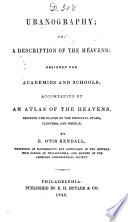 The squares of the periods of the planets are proportional to the cubes of their mean distances from the sun ; that is, ti2 : k2 ,• ,• ai3 ,• (h3This is the so-called harmonic law. The squares of the periods of the planets are proportional to the cubes of their mean distances from the sun ; that is, ti2 : k2 ,• ,• ai3 ,• (h3This is the so-called harmonic law.  Encyclopedia of the Solar System - Page 56redigeeritud poolt - 2006 - 992 lehteLimited preview Encyclopedia of the Solar System - Page 56redigeeritud poolt - 2006 - 992 lehteLimited preview - About this book
 | John Gummere - 1842 - 516 lehte
...the sun and their mean distances from him, Kepler discovered that the squares of the periodical times of the planets are proportional to the cubes of their mean distances from him. 155. To find the position of the line of the apsides of the solar orbit. Let B and D, Fig. 24,... | |
 | Ezra Otis Kendall - 1845 - 408 lehte
...occupied in making a revolution. Kepler discovered that the squares of the periodic times of any two planets are proportional to the cubes of their mean distances from the sun. Take, for example, the Earth and Mars, whose periods are 365.2504 and 686.9796 days, and whose distances... | |
 | Augustus Young - 1846 - 304 lehte
...is an ellipse, of which the sun occupies one of the foci. 3. The squares of the times of revolution of the planets are proportional to the cubes of their mean distances from the sun, or of the semi-major axes of their orbits. And Mr. Norton says that " The first two Kepler assumed... | |
 | Edward Bruce (bookseller.), John Bruce - 1846 - 398 lehte
...the planets are ellipses, having the sun in one of their foci. 3rd The squares of the periodic times are proportional to the cubes of their mean distances from the sun. The secondary planets or satellites obey the same laws as the primary. They all move from west to east... | |
 | Roswell Park - 1847 - 632 lehte
...sun, pass over equal areas in equal times ; and 3. The squares of their times of annual revolution are proportional to the cubes of their mean distances from the sun. By the second law, the planets move slowest when farthest from the sun ; as the radius vector, being... | |
 | Mary Somerville - 1849 - 568 lehte
...appear to move inhyperbolas, like fig. 8. The third law is, that the squares of the periodic times of the planets are proportional to the cubes of their mean distances from the sun. The square of a number is that number multiplied by itself, and the cube of a number is that number... | |
 | Archibald Sandeman - 1850 - 222 lehte
...planet, are proportional to these lengths of time. (3) The squares of the periodic times of different planets are proportional to the cubes of their mean .distances from the sun, that is, of the semi-axes major of their elliptic orbits. If the sun and planets be considered material... | |
 | James M'Intire - 1850 - 352 lehte
...describes areas proportional to the times. 3. That the squares of the periodic times of the earth and planets, are proportional to the cubes of their mean distances from the sun, or to the cubes of the semi-major axes of their orbits. These laws of the earth, and planets 86. Describe... | |
 | Thomas Kentish - 1852 - 272 lehte
...conjunction with that of E. According to Kepler's famous discovery, the squares of the periodic times of the planets are proportional to the cubes of their mean distances. Now, since the line A is laid down twice, and the line E thrice, in the same space, when the slide... | |
 | Auguste Comte - 1853 - 562 lehte
...last his labour issued in the discovery that the squares of the times of the planetary revolutions are proportional to the cubes of their mean distances from the sun : a law which all subsequent observations have verified. One important result of this law is that we... | |
| |